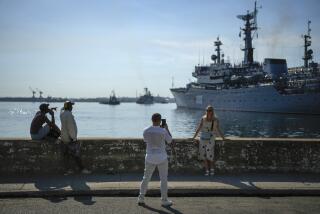Jeffrey Milstein’s Cuba photographs to be published in new book
Photographer Jeffrey Milstein wanted to visit Cuba in 2004, but travel restrictions were tight. The U.S. State Department granted permission mainly to religious and educational organizations.
So Milstein worked through Jewish Solidarity, a Miami-based nonprofit that brought medicine, food and other supplies to sites such as synagogues in Cuba. In his free time he wandered the streets away from tourist spots, meeting people and discovering new places.
In the last 10 years he’s taken eight trips and snapped thousands of images of street life, architecture, cars and public spaces. A hundred were compiled in the 2010 book “Cuba: Photographs by Jeffrey Milstein” and some were exhibited at Kopeikin Gallery in Los Angeles in 2011. Milstein hopes that his new work, including pictures from two trips in 2014, will be published in another book this year.
“I wasn’t searching out the beautiful estates but meeting people and photographing how common folks lived,” said Milstein, who traveled through Havana, Trinidad and Santiago. His favorite: the Malecón, a five-mile promenade stretching along Havana’s sea wall that is known for its colonial architecture mixed with Baroque and neoclassical monuments.
The historic center of Camagüey and the colonial plazas in Old Havana have been declared UNESCO World Heritage Sites, and Midcentury Modern and Art Deco structures still stand in the capital as well, including the former Bacardi rum building and the Havana Hilton, built in 1958 by Welton Becket, who based the design on the Beverly Hilton.
Milstein, who studied architecture at UC Berkeley, starkly contrasts stately buildings with abandoned structures. Despite decades of deterioration, vibrant Caribbean pink, turquoise and yellow stand out.
“They are not afraid to use color or paint,” Milstein said. “It’s one of the few ways people could express themselves artistically.”
When Raúl Castro officially took over for his ailing brother Fidel Castro in 2008, the photographer began noticing the use of cellphones, computers and microwaves. Perhaps the most consequential change was the emergence of private enterprise.
“The state-run restaurants were really awful, so locals would run paladares in their homes,” Milstein said. “I was pleasantly surprise how good the food was on my last trip.”
More to Read
The biggest entertainment stories
Get our big stories about Hollywood, film, television, music, arts, culture and more right in your inbox as soon as they publish.
You may occasionally receive promotional content from the Los Angeles Times.










